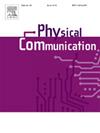Adaptive algorithm for compressed sensing channel estimation in underwater acoustic OFDM systems
IF 2
4区 计算机科学
Q3 ENGINEERING, ELECTRICAL & ELECTRONIC
引用次数: 0
Abstract
This study addresses channel estimation in low frequency, shallow water environments, particularly when the channel exhibits cluster sparsity. To tackle this, we propose the cluster adaptive step-size stagewise orthogonal matching pursuit (CAS-StOMP) algorithm, which selects consecutive atoms correlated with the residuals using the Dice criterion to capture the channel cluster sparsity. Herein, the step size is adjusted based on the difference in energy between channel estimation results. When the energy difference is large, the step size increases to accelerate convergence; otherwise, a smaller step size is adopted to improve the estimation accuracy. This approach enhances the accuracy and convergence speed. Simulation results show that the proposed algorithm achieves a lower bit error rate (BER) and higher output signal-to-noise ratio (SNR) in low frequency, shallow water acoustic communication as compared with other algorithms that consider only general sparsity.
水声OFDM系统压缩感知信道估计的自适应算法
本研究解决了低频、浅水环境下的航道估计,特别是当航道表现出簇稀疏性时。为了解决这个问题,我们提出了簇自适应步长阶段正交匹配追踪(CAS-StOMP)算法,该算法使用Dice准则选择与残差相关的连续原子来捕获信道簇稀疏性。其中,根据信道估计结果之间的能量差来调整步长。当能量差较大时,步长增大,加速收敛;否则,采用较小的步长来提高估计精度。该方法提高了算法的精度和收敛速度。仿真结果表明,与只考虑一般稀疏性的其他算法相比,该算法在低频浅水水声通信中具有较低的误码率和较高的输出信噪比。
本文章由计算机程序翻译,如有差异,请以英文原文为准。
求助全文
约1分钟内获得全文
求助全文
来源期刊

Physical Communication
ENGINEERING, ELECTRICAL & ELECTRONICTELECO-TELECOMMUNICATIONS
CiteScore
5.00
自引率
9.10%
发文量
212
审稿时长
55 days
期刊介绍:
PHYCOM: Physical Communication is an international and archival journal providing complete coverage of all topics of interest to those involved in all aspects of physical layer communications. Theoretical research contributions presenting new techniques, concepts or analyses, applied contributions reporting on experiences and experiments, and tutorials are published.
Topics of interest include but are not limited to:
Physical layer issues of Wireless Local Area Networks, WiMAX, Wireless Mesh Networks, Sensor and Ad Hoc Networks, PCS Systems; Radio access protocols and algorithms for the physical layer; Spread Spectrum Communications; Channel Modeling; Detection and Estimation; Modulation and Coding; Multiplexing and Carrier Techniques; Broadband Wireless Communications; Wireless Personal Communications; Multi-user Detection; Signal Separation and Interference rejection: Multimedia Communications over Wireless; DSP Applications to Wireless Systems; Experimental and Prototype Results; Multiple Access Techniques; Space-time Processing; Synchronization Techniques; Error Control Techniques; Cryptography; Software Radios; Tracking; Resource Allocation and Inference Management; Multi-rate and Multi-carrier Communications; Cross layer Design and Optimization; Propagation and Channel Characterization; OFDM Systems; MIMO Systems; Ultra-Wideband Communications; Cognitive Radio System Architectures; Platforms and Hardware Implementations for the Support of Cognitive, Radio Systems; Cognitive Radio Resource Management and Dynamic Spectrum Sharing.
 求助内容:
求助内容: 应助结果提醒方式:
应助结果提醒方式:


